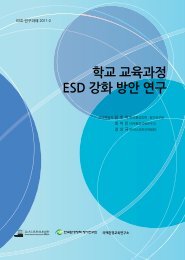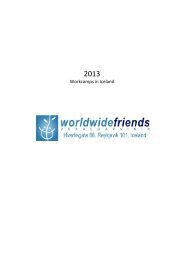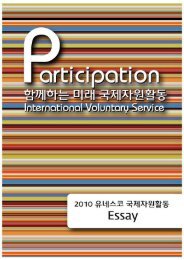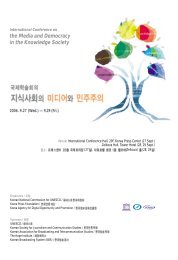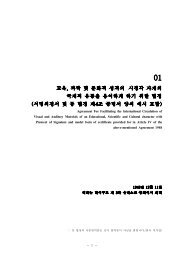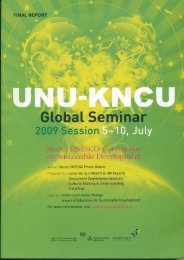íëìë³´ë2012문íì ë°ì ë¼ì´ëí ì´ë¸.pdf - ì ë¤ì¤ì½íêµììí
íëìë³´ë2012문íì ë°ì ë¼ì´ëí ì´ë¸.pdf - ì ë¤ì¤ì½íêµììí
íëìë³´ë2012문íì ë°ì ë¼ì´ëí ì´ë¸.pdf - ì ë¤ì¤ì½íêµììí
Create successful ePaper yourself
Turn your PDF publications into a flip-book with our unique Google optimized e-Paper software.
epository for history and culture; and (f) authentic value that symbolizes uniqueness and<br />
authenticity 5 . In short, cultural value indicates culture that is not just an instrument of<br />
development but a multifaceted concept that is a basic developmental factor.<br />
Similarly, Taejoo Lee (2012) viewed the relationship between culture and development<br />
from two separate perspectives: Culture in Development (CID) and Culture and<br />
Development (CAD). The former highlights the importance of culture in the development<br />
process and thus focuses on the development strategy where culture is viewed as a means; the<br />
essence of culture is thought to be the very basis of happiness, identity, and sustainability,<br />
while cultural values are recognized as the purpose of development. This classification is in<br />
line with Throsby's suggestions 6 .<br />
When looking at the relationship between culture and development from the perspective of<br />
classifications for international development cooperation, the domain of economic value or<br />
CID may be regarded as the basis for the sector of development, since culture is viewed as a<br />
tool for development. Cultural value or CAD, on the other hand, can be approached as an<br />
interdisciplinary or cross-cutting issue since culture here is examined as a purpose or basis<br />
across overall areas of international development.<br />
II. Why is Culture Yet to be Established as a Sector of Development?<br />
Is culture a sector of development? It is not, at least on the institutional dimension of<br />
current international development practices. As illustrated in the table below, major<br />
international aid organizations have designated education, public health, environment<br />
(climate change and water resources), and governance as common aid areas, while choosing<br />
additional sectors depending on the circumstances of individual countries.<br />
(Table) Classification of development sectors by international aid organizations<br />
World Bank<br />
DFID<br />
(United Kingdom)<br />
USAID<br />
(United States)<br />
KOICA<br />
(Korea)<br />
Education Education Education and training Education<br />
Health and social<br />
services<br />
Health Global health Health<br />
Climate change and<br />
environment<br />
Environment Climate change<br />
<br />
5 Throsby (2012), p. 54<br />
6 Lee, Taejoo (2012). A new trend of international development cooperation in the field of culture. 2nd<br />
Roundtable on Culture and Development: Cultural Contemplation of and Alternatives to Korea's International<br />
Development Cooperation. UNESCO. p. 52.



